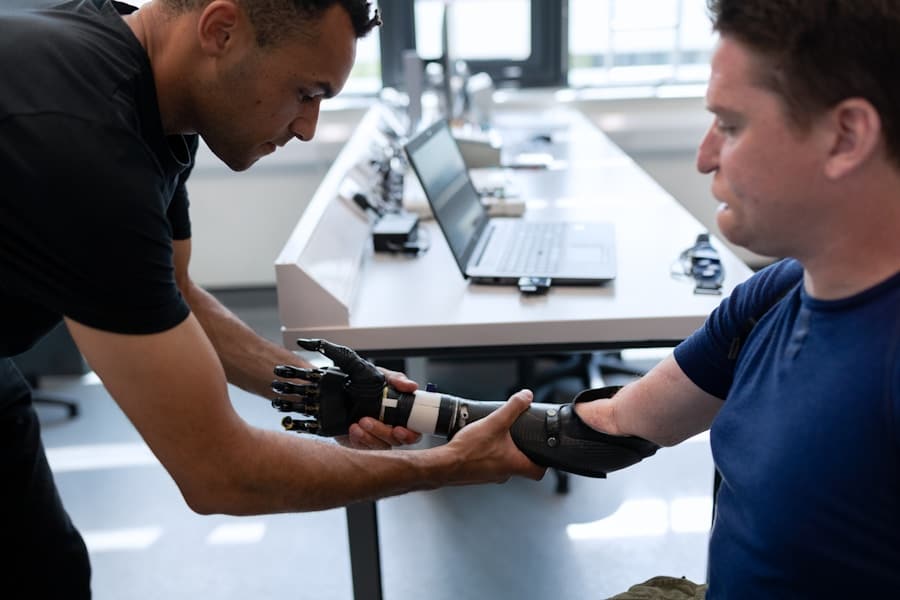Augmented Reality (AR) has emerged as a transformative technology in various sectors, and healthcare is no exception. AR-enabled wearables, such as smart glasses and headsets, overlay digital information onto the physical world, providing healthcare professionals with real-time data and visualizations that enhance their decision-making capabilities. These devices are designed to improve the efficiency and accuracy of clinical procedures, facilitate training and education, and ultimately enhance patient care.
The integration of AR into clinical environments represents a significant shift in how medical professionals interact with information and patients, allowing for a more immersive and interactive experience. The adoption of AR-enabled wearables in healthcare is driven by the need for innovative solutions to complex challenges. As the healthcare landscape evolves, professionals are increasingly tasked with managing vast amounts of data while ensuring high-quality patient care.
AR technology addresses this need by providing intuitive interfaces that allow clinicians to visualize patient data, anatomical structures, and procedural guidelines without diverting their attention from the patient. This seamless integration of digital information into the clinician’s field of view not only enhances situational awareness but also fosters a more collaborative environment among healthcare teams.
Key Takeaways
- AR-enabled wearables have the potential to revolutionize clinical environments by providing real-time information and enhancing medical procedures.
- Current applications of AR-enabled wearables in healthcare include surgical navigation, medical training, and patient education.
- Advantages of AR-enabled wearables in clinical environments include improved accuracy, efficiency, and reduced errors, while limitations include cost and technical challenges.
- Potential future developments in AR-enabled wearables for healthcare include expanded use in telemedicine, remote patient monitoring, and personalized treatment plans.
- AR-enabled wearables have the potential to improve patient care and outcomes by providing better visualization, decision support, and patient engagement.
Current Applications of AR-Enabled Wearables in Healthcare
The current applications of AR-enabled wearables in healthcare are diverse and impactful. One prominent use case is in surgical settings, where AR technology assists surgeons by overlaying critical information directly onto the surgical field. For instance, devices like Microsoft HoloLens have been utilized in complex surgeries to project 3D models of a patient’s anatomy, allowing surgeons to visualize structures such as blood vessels and organs in real-time.
This capability not only aids in preoperative planning but also enhances intraoperative decision-making, leading to improved surgical outcomes. In addition to surgical applications, AR-enabled wearables are being employed in medical training and education. Medical students and residents can use AR devices to engage with interactive simulations that replicate real-life scenarios.
For example, AR can provide a virtual anatomy lesson where students can manipulate 3D models of human organs, gaining a deeper understanding of spatial relationships and physiological functions. This hands-on approach to learning fosters better retention of knowledge and prepares future healthcare professionals for the complexities of patient care.
Advantages and Limitations of AR-Enabled Wearables in Clinical Environments
The advantages of AR-enabled wearables in clinical environments are manifold. One significant benefit is the enhancement of situational awareness for healthcare providers. By providing real-time access to patient data, imaging results, and procedural guidelines, these devices enable clinicians to make informed decisions quickly.
This immediacy can be particularly crucial in emergency situations where every second counts. Furthermore, AR technology can reduce the cognitive load on healthcare professionals by presenting information in a visually intuitive manner, allowing them to focus more on patient interaction rather than sifting through electronic records. However, despite their potential, AR-enabled wearables also face limitations that must be addressed for widespread adoption.
One major concern is the issue of user acceptance; healthcare professionals may be hesitant to adopt new technologies due to concerns about usability or the learning curve associated with integrating AR into their workflows. Additionally, technical challenges such as battery life, device weight, and connectivity issues can hinder the effectiveness of these wearables in fast-paced clinical environments.
Potential Future Developments in AR-Enabled Wearables for Healthcare
Looking ahead, the potential future developments in AR-enabled wearables for healthcare are promising and could revolutionize patient care further. One area ripe for innovation is the integration of artificial intelligence (AI) with AR technology. By leveraging AI algorithms, AR devices could analyze patient data in real-time and provide predictive insights that guide clinical decision-making.
For instance, an AI-enhanced AR system could identify anomalies in imaging studies or suggest personalized treatment plans based on a patient’s unique medical history. Another exciting avenue for development is the expansion of telemedicine capabilities through AR-enabled wearables. As remote consultations become more prevalent, integrating AR technology could enhance virtual visits by allowing healthcare providers to visualize patient conditions more effectively.
For example, a physician could use an AR headset during a telehealth appointment to guide a patient through self-examinations or provide step-by-step instructions for at-home care. This level of interactivity could bridge the gap between in-person and remote care, ensuring that patients receive comprehensive support regardless of their location.
Impact of AR-Enabled Wearables on Patient Care and Outcomes
The impact of AR-enabled wearables on patient care and outcomes is profound and multifaceted. By enhancing the capabilities of healthcare providers, these devices contribute to improved diagnostic accuracy and treatment efficacy.
This increased confidence can lead to reduced surgical errors and shorter recovery times for patients. Moreover, AR-enabled wearables can significantly enhance patient engagement and education. When patients are involved in their care process through interactive visualizations or guided instructions provided via AR devices, they are more likely to understand their conditions and adhere to treatment plans.
For example, an AR application could allow patients to visualize their treatment progress or understand the mechanics of their prescribed therapies through immersive experiences. This empowerment fosters a collaborative relationship between patients and providers, ultimately leading to better health outcomes.
Regulatory and Ethical Considerations for AR-Enabled Wearables in Healthcare
As with any emerging technology in healthcare, regulatory and ethical considerations surrounding AR-enabled wearables are paramount. Regulatory bodies such as the Food and Drug Administration (FDA) play a crucial role in ensuring that these devices meet safety and efficacy standards before they can be widely adopted in clinical settings. The classification of AR-enabled wearables as medical devices necessitates rigorous testing and validation processes to assess their impact on patient safety and treatment outcomes.
Ethical considerations also come into play when discussing the use of AR technology in healthcare. Issues related to data privacy are particularly pressing; as these devices collect and process sensitive patient information, ensuring compliance with regulations like HIPAA is essential. Additionally, there is a need for transparency regarding how data is used and shared among stakeholders within the healthcare ecosystem.
Clinicians must be equipped with clear guidelines on ethical practices when utilizing AR technology to maintain trust with patients while leveraging its benefits.
Integration of AR-Enabled Wearables with Electronic Health Records and Other Healthcare Systems
The integration of AR-enabled wearables with electronic health records (EHR) and other healthcare systems is critical for maximizing their potential impact on clinical workflows. Seamless interoperability between these technologies allows healthcare providers to access comprehensive patient information without interruption during procedures or consultations. For instance, an AR device that pulls data directly from an EHR can display relevant medical history or lab results in real-time, enabling clinicians to make informed decisions based on the most current information available.
Moreover, integrating AR technology with telehealth platforms can enhance remote care delivery by providing clinicians with access to patient data while interacting with patients virtually. This integration ensures that healthcare providers have all necessary information at their fingertips during consultations, leading to more effective communication and better-informed treatment decisions. As healthcare systems continue to evolve towards more interconnected models, the synergy between AR-enabled wearables and existing technologies will be essential for improving overall efficiency and patient outcomes.
The Future of AR-Enabled Wearables in Clinical Environments
The future of AR-enabled wearables in clinical environments holds immense promise as technology continues to advance at an unprecedented pace. With ongoing developments in AI integration, telemedicine capabilities, and enhanced user interfaces, these devices are poised to become indispensable tools for healthcare professionals across various specialties. As barriers related to regulatory compliance and ethical considerations are addressed, the adoption of AR technology will likely accelerate, leading to transformative changes in how care is delivered.
As we look forward to this future landscape, it is essential for stakeholders—including healthcare providers, technology developers, regulators, and patients—to collaborate closely in shaping the evolution of AR-enabled wearables. By prioritizing user-centered design, robust training programs, and transparent data practices, we can ensure that these innovative tools enhance not only clinical efficiency but also the quality of care delivered to patients worldwide. The journey toward fully realizing the potential of AR-enabled wearables in healthcare is just beginning, but its trajectory promises a new era of enhanced patient engagement and improved health outcomes.
In a recent article discussing the future of AR-enabled wearables in clinical environments, it is important to consider the software that will be used to enhance user experience. According to a related article on the best Apple laptops and the best HP laptops provide valuable insights into the latest innovations in hardware that will support the integration of AR technology in clinical environments.
FAQs
What are AR-enabled wearables?
AR-enabled wearables are devices that combine augmented reality (AR) technology with wearable devices, such as smart glasses or headsets, to overlay digital information onto the user’s real-world environment.
How are AR-enabled wearables used in clinical environments?
In clinical environments, AR-enabled wearables can be used to provide healthcare professionals with real-time access to patient data, medical imaging, and procedural guidance, as well as to facilitate remote collaboration and training.
What are the potential benefits of AR-enabled wearables in clinical settings?
The potential benefits of AR-enabled wearables in clinical settings include improved efficiency and accuracy in medical procedures, enhanced visualization of patient data and anatomy, and the ability to provide personalized and context-aware information to healthcare professionals.
What are some examples of AR-enabled wearables being used in healthcare?
Examples of AR-enabled wearables being used in healthcare include smart glasses that provide surgeons with real-time imaging and data during procedures, as well as AR headsets that assist healthcare professionals in locating veins for blood draws and IV placements.
What are the challenges and limitations of AR-enabled wearables in clinical environments?
Challenges and limitations of AR-enabled wearables in clinical environments include concerns about data privacy and security, the need for seamless integration with existing healthcare systems, and the potential for user distraction and cognitive overload.



